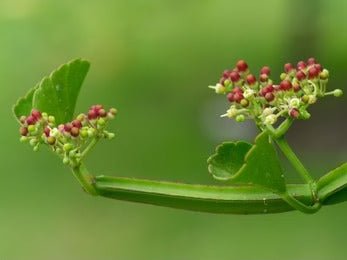Cissus quadrangularis, often called Hadjod, is a perennial plant in the Vitaceae family. Adamant creeper, square stalked vine, veldt grape, devil's backbone, hadjod and pirandai, Sannalam, Nalleru, Vajravelli, and Mangara Valli are some of the names for it. The hadjod plant is indigenous to Sri Lanka, Bangladesh, and India. It can also be found in Southeast Asia and Africa. For its applications, it is being imported to Brazil and the southern United States.
Quadrangular Cissus The plant has branches with quadrangular sections and internodes that are between 8 and 10 cm long and 1.2 and 1.5 cm wide. It has a 1.5 m maximum height.. A leathery edge runs along each angle. At the nodes, toothed trilobe leaves 2 to 5 cm wide begin to develop. Each Hadjod leaf has a tendril coming out of the node's other side. Hadjod plants produce racemes of little white or greenish flowers and globular berries, which become red when ripe.
Hadjod Ayurvedic View
The succulent herb Cissus quadrangularis is a member of the Vitaceae family. It has a cactus-like, squishy texture. It is also known as Lycopodium imbricatum, Heliotropium indicum, and Vitis quadrangularis. also frequently referred to as a Hadjob. It has several different uses in Ayurveda, including Pachan dravya (digestive assistance), Sara (alleviates constipation), Athiyuk (strengthens bones), Vrushya (aphrodisiac), etc. It is utilized to cure gastritis in Unani medications. While the powdered root of the Hadjod plant is primarily used to treat bone fractures and conditions connected to bones, the entire Hadjod plant is used to cure asthma. Hadjod powder is taken in doses of 30 to 40. In Southern India, fresh shoots and leaves are widely consumed with curries and add a pleasant flavor.
The immature shoots of the Hadjod plant are dried, ground, and burned to ashes in Chennai. These plant ashes are used to treat indigestion, dyspepsia, and a few gastrointestinal disorders. Young shoots and hadjod leaves are regarded as potent choices for treating digestive issues. In cases of otorrhoea and epistaxis, Hadjod stem juice is squirted into the ear canal. There are numerous medicinal uses for hadjod herb.
Sanskrit refers to Cissus quadrangularis, often known as the "Bone Setter," as Asthisamharaka, which means "save the bones from their destruction."
Hadjod Synonyms
Hadjod, Hadsankal, Harjora, Nalleru, Vajravalli, Kandvel, Hadavhanga, Piranti, Vedhari, Horjora, and Harbhanga are some of the common names for the plant Vitis quadrangularis.
English: Adamant creeper, Edible stemmed vine, Bonesetter
Hindi: Harsankari, Hadjod, Hadjora, Hadsarihari, Kandvel
Bengali: Har, Harbhanga, Hasjora, Horjora
Gujarati: Chodhari, Hadsand, Hadsankal, Vedhari
Kanada: Mangarahalli
Malyalam: Cannalamparanta, Peranta
Marathi: Horjora, Kandavel, Nalllar, Harsankar
Tamil: Piranti, Vajjravalli
Telugu: Nalleru, Nelleratiga, Vajravalli
Oriya: Hadavhanga
Urdu: Harjora, Hadsankal
Classifiaction of Cissus Quadrangularis
Kingdom: Plantae
Subkingdom: Tracheobionta
Super division: spermatophyta
Division: Magnoliophyta
Class: Magnoliopsida
Subclass: Rosidae
Order: Vitales
Family: Vitaceae
Genus: Cissus
Species: Quadrangularis
Ayurvedic Properties
|
Particular |
Hindi / Sanskrit |
English |
|
Rasa (Taste) |
Katu, Madhura |
Pungent, Sweet |
|
Guna (Action) |
Laghu, Ruksha, Sara |
Light, Dry, Unstable |
|
Virya (Potency) |
Ushna |
Hot |
|
Vipaka (Post-Digestive Taste) |
Katu |
Pungent |
|
Dosha Effect |
Vatahara |
Kaphahara |
Medicinal Properties of Hadjob
Hadjod has a lot of medical qualities. Knowing its characteristics will enable us to make better use of this herb for medical purposes.
The meaning of this herb and its medical effects are described below.
- Analgesic: Acting as a painkiller and pain reliever.
- Anti-Inflammatory: Reduces inflammation by acting on body systems.
- Anti-Osteoporotic: The entire plant has anti-osteoporotic action and is beneficial in preventing osteoporosis.
- Antioxidant: Strong antioxidant and free radical scavenging properties are present.
- Anti-Ulcer: By lowering stomach secretions and raising glycoprotein levels, it has strong anti-ulcer effects.
- Bone Healing: It has been demonstrated that its high calcium, phosphorus, and phytoestrogen steroid concentration influences the speedy mineralization and early regeneration of the bone fracture healing process.
- Central Nervous System Activity: The root extract has a depressive effect on the central nervous system.
Uses and Health Benefits
- Bone strength is increased.
- Enhances the healing of fractures.
- Reduces edema.
- Lessens the discomfort associated with fractures.
- Used both inside and outside.
- For faster healing, its paste is topically administered to fractures. the herb paste used locally.
- It indicates a reduction in the total healing time of the fracture where it is applied.
- It also speeds up the healing of broken jaw bones and exhibits excellent outcomes while lowering pain, edema, and fracture mobility.
- Its juice is used to alleviate nose bleeding, and its stem is helpful in the treatment of piles.
- For the purpose of bone healing, it aids in the accumulation and precipitation of calcium from blood.
Hadjod can also be used to treat asthma, gastrointestinal issues, indigestion, skin conditions, and irregular periods. Additionally, it helps regulate obesity and the side effects of metabolic diseases. Hadjod, also known as Cissus quadrangularis, possesses powerful fracture-healing abilities. It possesses excellent cholinergic, antimicrobial, antiulcer, antioxidant, anti-osteoporotic, and antimicrobial properties.

